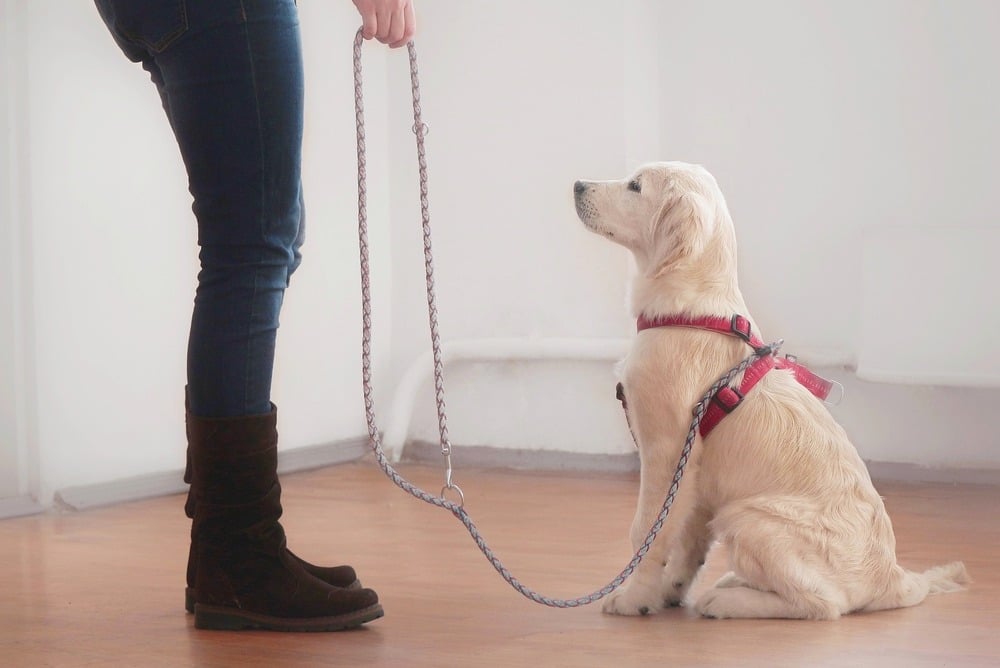Teaching your dog to walk on a leash is one of the first basic commands to be taught to your pet. Indeed, it is essential to walk safely and calmly, and subsequently, teach him how to walk without a leash and recall.
However, to succeed in this learning, it is important to understand its usefulness, know the precautions and procedures to follow, and be well-equipped. So, let’s know precautions to consider during leash training.
Here’s a breakdown of important precautions to consider when leash training, emphasizing patience, positive reinforcement, and the importance of creating a positive association with the leash.
Precautions for Successful Leash Training
- Quiet Start: Begin training in a low-distraction environment where your dog can focus on you, not everything else around them.
- Timing is Key: Choose a time when your dog is alert and receptive but not overly excited or hungry.
- Short and Sweet is Best: Keep training sessions brief (especially for puppies) to prevent frustration. Several short sessions a day are better than one long one.
- Be Positive, Not Punitive: Focus on rewarding them for walking nicely. Avoid harsh corrections, leading to fear and reluctance to walk on a leash.
- The Leash is Your Friend: Never use the leash as a tool to jerk or punish your dog. This creates a negative association with the leash itself.
- Gradual Progress is Success: Don’t rush! Master each step of leash training (getting used to the leash, loose-leash walking at home, etc.) before moving on to more challenging situations.
Additional Things to Avoid
- Letting Your Puppy Chew the Leash: Redirect their chewing to an appropriate toy. Chewing on the leash turns it into a game, not a training tool.
- Pulling Back on the Leash: Instead of pulling, stop or change direction when your dog pulls. This teaches them that pulling doesn’t get them anywhere.
- Losing Your Cool: Dogs sense our frustration. Stay calm and consistent; they’ll be more likely to learn what you ask them.
Key Takeaways
- Leash Training is About Relationship: It’s more than just making your dog walk where you want. It’s about building trust and a positive association with being on the lead.
- Patience is a MUST: Every dog learns at their own pace. Don’t get discouraged; keep things fun, and celebrate even the smallest successes.
- Equipment Matters: Ensure your dog’s collar/harness fits comfortably and the leash is sturdy enough for their size and strength.
Remember: Leash training should be a positive experience for you and your dog. You’ll transform those walks from a struggle into a joyful bonding experience with patience and the right approach!
Why Is It Important To Teach Your Dog To Walk On A Leash?
When your pet is young, he often does not yet have enough strength to pull too hard on his leash. But when he grows up, the problems begin. Indeed, a dog who does not know how to walk on a leash without pulling and who does as he pleases is difficult to manage.
Walking quickly becomes painful and unpleasant because you are forced to spend your time preventing your little companion from going right and left as he pleases.
However, a large dog who suddenly decides to follow a trail, approach another dog, or cross the street is a real danger. Not only can it compromise your safety and cause injury, but it can also throw you off balance to the point of causing you to fall or even cause an accident.
To make walks with your pet enjoyable for everyone, teach him to walk on a leash very early on. It is one of the bases of his education. Indeed, this order is useful for teaching him to walk without a leash and recall.
What Precautions To Consider During Leash Training?
Before learning to walk on a leash, we believe it is important to communicate to you certain precautions and basic rules of dog training to apply so that this teaching goes for the best.
- Choose A Suitable Learning Space:
For your dog to integrate each learning, he must listen to you. We must, therefore, prevent him from being disturbed by his environment and distracted by what surrounds him.
Take your pet to a calm, quiet space with as few sources of stimulation as possible but also secure. If you have a garden, this may be a good place to start, especially if your pet is energetic. Your living room can also do the job very well.
- Choose The Right Time:
Again, this is common sense. To get your pet to listen to you, you have to act at the right time. Please do not ask him when he is eating, sleeping, exhausted, or, on the contrary, too excited by the game. Wait until he is active but attentive.
Likewise, limit yourself to short sessions. The dog’s attention span is very short, which is why you should only undertake sessions lasting up to 10 to 15 minutes, and even 5 minutes for a puppy. Beyond that, he will get bored and perceive these lessons as unpleasant, making learning much more difficult.
- Show Kindness:
Do not use brutal methods to teach your dog commands. Violence, humiliation, and punishment are counterproductive. Of course, the animal ends up learning and reproducing what you have taught it, but it does so out of fear and not desire to satisfy you. This feeling of fear deteriorates your relationship as your puppy realizes he cannot trust you to keep him safe.
- Respect The Progression Of The Steps:
Your dog cannot learn a command like walking on a leash simply because you have explained how to do it or because you have once shown him the behavior he should adopt. It takes time to integrate an order, adopt it as a habit, and reproduce it correctly in all circumstances.
The dog learns in progressive stages. You will see below that learning to walk on a leash is divided into phases that must be respected. Before moving on to the next one, always make sure that the previous step is perfectly mastered; otherwise, you risk going back to square one and having to redo your entire teaching.
- Do Not Pull On The Leash:
Pulling a dog on a leash is common. However, it would help if you didn’t tug too hard on the leash. This may lead to your dog associating leashes negatively from a young age. The leash will become an evil object that prevents our dogs from moving. Leash training should be done to let our dogs explore as much as they want to while still keeping them safe.
- Don’t Let Your Puppy Chew On The Leash!:
Carefully remove it from the mouth, but do not pull or tear at yourself. Otherwise, the puppy will think you are starting a game of “who will pull who.” Hold the leash correctly. If it doesn’t dangle near your puppy’s face, it will be harder for him to reach it.
- Reward Your Dog:
Carry a few treats in your pocket or your hand opposite your dog’s walking side. Reward him regularly when he walks correctly on the leash that is, on the right side, without pulling or passing you while the leash is relaxed. You will be able to encourage him and congratulate him on his efforts, which will enable him to continue doing so.
Conclusion:
A leash will allow you to control the puppy, prevent it from running away, getting lost, or getting hit by a car, and help the owner protect the dog from other animals, inappropriate people, and children.
It is necessary to show the pet who is in charge of the house and accustom it to equipment from the first days,
so as not to subsequently end up with an uncontrollable dog. If, as a rule, there are no problems with a collar, then accustoming a puppy to a leash turns out to be a more difficult task. Detailed instructions will help you adapt your pet to a leash, and walking together will be safe and fun!


